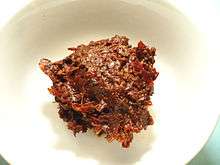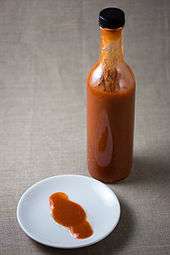Doubanjiang
Doubanjiang (Chinese: 豆瓣酱; pinyin: dòubànjiàng; IPA: [tôupântɕjâŋ]); or douban, toban-djan, broad bean chili sauce, fermented chili bean paste) is a hot and savoury Chinese bean paste made from fermented broad beans, chili peppers, soybeans, salt and flour. Doubanjiang is characteristically used in Sichuan cuisine, and has been called "the soul of Sichuan cuisine."[1][2] Sichuan dishes such as mapo tofu, huoguo (Sichuan hotpot), the Yuxiang flavour profile, and Shuizhu all use doubanjiang as a key ingredient. Other regions have their own versions: in regions such as Guangdong or Taiwan, the Sichuan doubanjiang is called la-doubanjiang (Chinese: 辣豆瓣酱, "la" (辣) meaning 'hot' or 'spicy') to distinguish it from local non-spicy versions.
| Doubanjiang | |||||||||||||||
|---|---|---|---|---|---|---|---|---|---|---|---|---|---|---|---|
 Spicy doubanjiang | |||||||||||||||
| Simplified Chinese | 豆瓣酱 | ||||||||||||||
| Traditional Chinese | 豆瓣醬 | ||||||||||||||
| Literal meaning | "bean segments sauce" | ||||||||||||||
| |||||||||||||||
Main Types
Pixian Doubanjiang
The most well-known variety of doubanjiang is arguably Pixian Doubanjiang (Chinese: 郫县豆瓣酱; pinyin: Píxiàn dòubànjiàng), named for Pixian, Sichuan.[3] Pixian Doubanjiang is produced with a long fermentation period under sunlight (often longer than 3 years). Pixian Doubanjiang has a reddish-brown color with a deep and complex umami profile.[4] The standard way to use it is to first fry it in oil before adding other ingredients, infusing the oil with its colour and fragrance.
Well-known brands of Pixian Doubanjiang commonly available in Asian grocery stores outside of China include:
- Juan-cheng ( Chinese: 鹃城牌)
- Chuan Lao Hui (Chinese: 川老汇)
- Dandan (Chinese: 丹丹)
Production Method
Pixian Doubanjiang is a Geographical Indication (GI) protected product, with its quality assessment standards last published in 2005. It states: [5]
- Ingredients
- must include Erjingtiao chili, sourced from Pixian and the surrounding districts within east Sichuan.
- Broadbeans sourced from east Sichuan or the neighbouring Yunnan province, up to GB/T 10459 standards.
- Water sourced from underground of Pixian, up to GB 5749 standards.
- Procedure:
- Soaking and de-shelling of selected broadbeans, the making of the Qu starter culture, and its fermentation into sweet broadbeans for more than 6 months.
- Salting and crushing of the Erjingtiao chili and its fermentation.
- Mixing of the broadbean culture with the Erjingtiao chilli culture in a particular ratio, and sundrying the mixture to allow for a futher fermentation of 3 months.
- Then the mature Pixian Doubanjiang product is yielded.
- Quality assessment: resultant products are graded to 3 classes.
- Premium grade: red/brown in colour, coated in glistening oil, strong aroma of the chilli with rich savouriness, broadbean bits crisp and fragrant, disintegrate upon crushing, lasting aromatic aftertaste.
- Grade I: light red/brown in colour, partially coated in glistening oil, chilli aroma and savrouriness moderately rich.
- Grade II: red or light red/brown in colour, glistens but not coated in oil, broanbean bits lacking fragrance, no lasting aftertaste.
- Quantitative analysis: total acids (in lactic acids) <= 2.0 g/100g. Salt (in NaCl) 15-22g/100g.
Others
Doubanjiang may be produced at home with just soybeans, salt and spices. Normal home-made or factory-produced doubanjiang rarely has the long fermentation time that gives the Pixian version its character.
Hongyou Doubanjiang (Chinese: 红油豆瓣, doubanjiang in red chili oil) is sometimes confused with Pixian Doubanjiang. Hongyou Doubanjiang is not fermented however, it usually contains extra spices and the chili oil can be made from any chili variety.
Doubanjiang used outside of Sichuan is often not spicy. The variety of Doubanjiang produced by Lee Kum Kee is widely available outside China, and is a classic Cantonese-style Doubanjiang.
See also
- Fermented bean paste
- Doenjang
- List of fermented foods
- List of fermented soy products
- Douchi (Chinese fermented black beans)
- Ssamjang
- Gochujang
References
- Holliday, Taylor. "Sourcing Pixian Douban Jiang (Chili Bean Paste)". The Mala Project. Retrieved 28 February 2016.
- Yanlin. "Sichuan Cuisine". Way of China. Retrieved 5 August 2019.
- Holliday, Taylor. "Sourcing Pixian Douban Jiang (Chili Bean Paste)". The Mala Project. Retrieved 28 February 2016.
- Luo, Elaine. "Doubanjiang - Broad Bean Paste(豆瓣酱)". China Sichuan Food. Retrieved 5 August 2019.
- "Pixian Doubanjiang - Baidu Baike".

